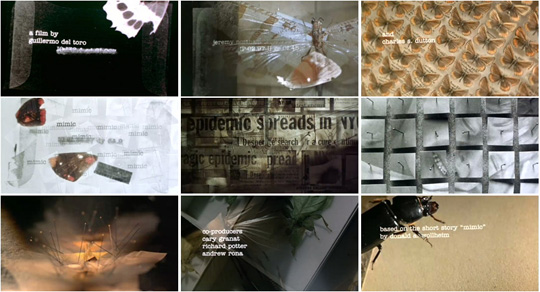"In Manhattan, cockroaches are spreading a deadly disease that is claiming hundreds of the city's children.Entomologist Susan Tyler (Mira Sorvino) uses genetic engineering to create what she and her colleague (and husband) Peter Mann (Jeremy Northam) call the Judas Breed, a large insect (looking like a cross between a termite and a praying mantis) that releases an enzyme that kills off the disease-carrying roaches by speeding up their metabolism. The Judas Breed work spectacularly and the crisis is abated. Since the Judas Breed have also been designed to only produce one male able to breed, and they keep it in their care, the hybrid species should die out in a matter of months.
Some years later, people begin to go missing in the subways and tunnels under the city. Susan, Peter, and their staff learn that they severely underestimated the Judas Breed's ability to adapt to its conditions. The Judas Breed has found a way to reproduce and has evolved in order to better hunt a new food source. To everyone's horror, they discover that the Judas' new food source is humans, and now the insects have grown to be as big as people and can mimic the appearance and behavior of humans with uncanny accuracy. Susan and Peter have learned that huge swarms of the Judas Breed are living beneath the city in the subway system, and with the help of Leonard (Charles S. Dutton), a transit system police officer, they search out the insects, whose quick evolution (one fertile male and hordes of females) also made them humanoid, before they can take over the city and from there the world." -wikipedia
Mise-en-scene
Similar to opening title sequences like ‘Se7en’, this sequence has a dark over tone over the filming. The filming looks as if it has a desaturated effect over it; this use of colour effect adds edge to the emotions being felt by the audience.
The lighting in ‘Mimic’ changes constantly, there is a dramatic sharp change from dark to light-this same pattern of dynamic alterations in light creates a disturbing, confusing effect on the mind of the audience. The title sequence’s use of lighting helps to suggest the type of genre of the film. This highlights the fast pace narrative of the film. The opening sequence features no actors therefore there’s no introduction to the characters leaving the audience questioning who the main characters of the film are. Normally the genre of thriller and horror include the element of suspense and the unknown, this could be a reason why there are no characters featured in the opening sequence. Opening sequence’s normally include a backing sound track or a voice over although ‘Mimic’ has a dynamic composition of a variety of sounds; sometimes this is just a short tune created by sharp sounds then at very random points a voice over is heard although this voice over sounds like a radio transmission. The title sequence includes various camera shots they change rapidly to increase the pace and the amount of features found within any one frame.
Purpose and Character
One major element missing in the title sequence of ‘Mimic’ is there is no characters, where the camera shots are moving so fast there is hardly a second to take everything-creating almost a claustrophobic environment for the audience. Many of the images in the sequence are jumbled perhaps suggesting there are a lot of mixed characters in the film itself. This jumbled effect also creates a disturbed state of mind for the viewers to consider enabling them to make links through the variety of images shown in the title sequence. Throughout the sequence as the titles appear so do images of destroyed butterflies; this could suggest destruction of nature and therefore leading to destruction of the mind. The direct contrast of the destroyed butterflies and then the perfectly displayed butterflies shows there is a fine line between both beauty and destruction. This juxtaposition could represent the mix of good hearted and cold twisted characters who develop in the narrative. Also featured in the opening titles are images which look as if they are school profile shots, the same photo is not repeated showing that the focus is not on one person but many; this could highlight the need to keep a constant trail of thought throughout the film to try and work out for yourself what is going on as different events are occurring. In other words, linking past events to the present.
Cinematography
This opening title sequence includes many close ups and extreme close up’s which make the surrounding extremely focused on a particular point. The majority of the lighting in this title sequence is dull; this dullness is used to create a frightening and unpleasant atmosphere. The use of dull elements does not stop at the lighting it continues into the colours, which are included. The main bulk of colours are rather dark such as shades of brown, black, and charcoal grey. These colours contribute a dark menacing tone to the entire title sequence. Soft edged rays of light appear over some of the elements featured in the frame; this could emphasise the different events, which happen during the film are very dark and mysterious. Fast pace has been used to include many things creating excitement towards the movie, leaving the audience with a desire to want more. The negative effect, the change in colour on some of the images is very unexpected and shocking revealing what they truly are. In relation to the film this could mean that some of the characters become seen to be who they really are; this leaves the audience questioning the different characters identities. All the things included in the title sequence portray the things which the director enjoys featuring in his work, "I have a sort of a fetish for insects, clockwork, monsters, dark places, and unborn things."


No comments:
Post a Comment